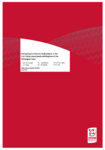Co-seismic subsidence in Hutt Valley from Wellington fault rupture
Search in document library
Purpose of the report to estimate land subsidence in Lower Hutt Valley from a Wellington Fault earthquake using geological and geotechnical data.
Geographic Area Covered
Lower Hutt Valley, Wellington Region, New Zealand, including Petone, Alicetown, Moera, Seaview and surrounding suburbs.
Summary
This report investigates how much the ground in Lower Hutt Valley could sink during a major earthquake on the Wellington Fault. The area is known to be geologically active, with past earthquakes causing significant changes to the land. Using data from deep boreholes, historical records, and modern elevation surveys, scientists calculated how much land has sunk over thousands of years. They also considered how past sea levels and soil compression affect these measurements. To isolate the effect of the Wellington Fault, they removed the influence of the nearby Wairarapa Fault, which caused uplift in 1855. Beach ridges at Turakirae Head were used to estimate how much land typically rises during Wairarapa Fault earthquakes. By comparing this with uplift in the Hutt Valley, they determined how much subsidence is likely due to the Wellington Fault alone. The study found that in an average Wellington Fault earthquake, land in Petone could sink by about 1.9 metres, with slightly less subsidence in Alicetown and Seaview. This would result in large areas falling below sea level, increasing the risk of flooding and drainage problems. The report also considered best-case and worst-case scenarios, with subsidence ranging from 0.75 to 2.8 metres depending on the earthquake’s size. Maps were created showing which areas would be underwater after such an event. The findings highlight the need for careful planning, especially for critical infrastructure and emergency services. Recommendations include updating city plans, limiting development in high-risk areas, and educating the public about the risks. The report stresses that doing nothing is not an option and encourages councils to consider managed retreat, improved emergency planning, and engineering solutions. It also suggests further research to better understand earthquake recurrence and subsidence patterns. Overall, the report provides a detailed and evidence-based assessment of earthquake-related subsidence risks in Lower Hutt Valley, helping inform future land use and hazard management decisions.
